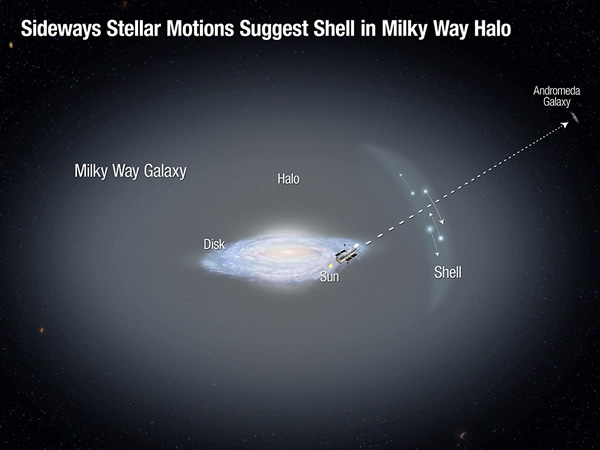Are Star 'Crumbs' Evidence of Galactic Cannibalism?
Are Star 'Crumbs' Evidence of Galactic Cannibalism?
What happens when a galaxy “eats” another? Galactic cannibalism is when a smaller galaxy merges into a larger galaxy like the Milky Way. Though the stars are scattered by the process, sometimes a tell-tale signature remains — like the crumbs left over after a cannibalistic feast.
Such a signature may have been found recently in our own Milky Way halo using the Hubble Space Telescope. Though our Galaxy is a spiral type, with a large disk of stars and gas with a radius of 50,000 light years as its main feature, it also sports a large spherical halo of old stars and dark matter that extends many times beyond the spiral arms. Because the halo is so large, and halo stars so few and far between, getting an accurate measure of the motions of halo stars is a challenge.
So, into the Hubble archives went Alis Deason and her collaborators, specifically to seven years worth of images taken of the Andromeda Galaxy in order to determine the “proper” motion (or sideways motion on the sky) of that galaxy. The Milky Way stars were cluttering junk for that study, but they became the main focus for this work.
After some painstaking work looking at stellar spectra and color-magnitude diagrams, they identified 13 stars that belonged to the halo of the Milky Way. These stars are roughly 80,000 light years away from the Galactic Center, and they are moving in a way that was unexpected. Studies of halo stars much closer in show that they have a large radial component to their motion, that is, they are dive-bombing quickly into or away from the disk. Current models of galaxy formation indicate that this trend should continue further out into the stellar halo.
However, this is not the case in the new measurements. With the exquisite precision afforded by Hubble optics, the team were are to get the full velocity of these 13 distant stars. There was significant motion in a tangential, or sideways, direction with respect to the galactic center. This indicates that something else is happening that isn’t in previous models.
The favored explanation seems to be that of a “galactic shell” of stars left over from the “eating” of a smaller galaxy by the Milky Way in the distant past. Such shells are visible in the halos of other galaxies, and the Milky Way is known to have streams of stars that hang together after a smaller galaxy has been ripped apart. Since these halo stars are so far out, they may trace an even more distant past. Other explanations include a new stream of stars, stars that have formed in the halo itself, or a rotation of the halo that has not been accounted for.
This pilot study was only done, however, with only 13 stars over a very small region of sky, whereas the halo envelopes us in every direction. Naturally, the team intend to continue looking for highly accurate data sets of other regions of the sky with similarly long time periods of monitoring. The proper motion study of Andromeda just happened to be a good place to start, since the data already existed to look for the tiny proper motions of distant stars.
As well as telling the merger history of our Galaxy, these stars are also in the further region of the halo that becomes dominated by dark matter. A close study of their motion might then reveal the true shape of the dark matter halo surrounding us, giving us more insight into that mysterious “stuff” that is so prevalent in the Universe.
What other gems lurk in the data archives of Hubble and the other large telescopes that have yet to be discovered?
Feb 25, 2013 02:21 PM ET by Nicole Gugliucci












